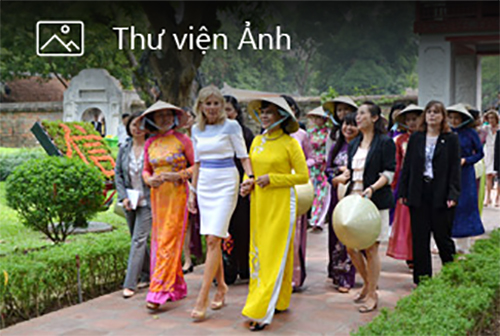VAN MIEU – QUOC TU GIAM DURING THE PERIOD 1802-1945
Under the Nguyen dynasty, Thang Long was not considered as the capital, but it became the center of the Hoai Duc prefecture, later belonged to Northern Citadel region. During this period, Van Mieu was called Van Mieu Bac Thanh and later changed its name to “Van Mieu Hanoi”. Quoc Tu Giam and became the school of Hoai Duc prefecture and developed into the Khai Thanh Shrine dedicated to Confucius’ parents.
During this time, Van Mieu Hanoi was dedicated to Confucius and his 4 best disciples in the Great Sanctuary. The East and West wings were for the worship of 72 Confucian sages. The Khai Thanh Shrine was a place for honoring Confucius’ parents. However this vestige no longer had the function of an advanced educational center in the country, but with its special significance Van Mieu of the Northern Citadel region was paid attention and was restored during the Nguyen dynasty.
In 1805, the Khue Van Cac (constellation pavilion) was constructed by Nguyen Van Thanh, the chief of the Northern Citadel region at Van Mieu. It is such a unique architectural project: it is a wooden square pavilion with double roofs of pipe shaped tiles; it was erected on a square foundation tiled with Bat Trang bricks. The pavilion was built on 4 square brick pillars. The edges of the pavilion are wooden, its roofs were covered with pipe shaped tiles and 4 circular windows attached with spikes radiating outward, symbolizing the shining Khue constellation, that “monitors literature” which gives high regard to the Confucian educational center, and this has contributed to increasing the cultural and artistic values of Van Mieu - Quoc Tu Giam.
In 1808, after the construction of Van Mieu in the Capital Hue, the Nguyen dynasty ordered Van Mieu should be in different localities with Van Mieu of the Northern Citadel region honoring the tablet of Confucius, but not for worshiping his statue. If any place had statues they had to look for a clean land to bury them. Hence, Van Mieu had only worshipping tablets of Confucius and Confucian sages.
In 1827, under the reign of the King Minh Menh, an order was given to collect printing blocks of Ngu Kinh (Five Classics) and Tu Thu Dai Toan (Complete Four Books) and Vo Kinh Truc Giang in Van Mieu of the Northern Citadel region and bring them to Quoc Tu Giam in the capital of Hue. In 1833, the Great House of Ceremony and the Great Sanctuary were repaired and repainted; the surrounding walls of Van Mieu were rebuilt. In 1858, two pavilions on the right and left housing steles were constructed, with 11 rooms each. In 1863, Hoang Giap (official doctoral laureate), treasurer of Hanoi Le Huu Thanh and An sat (the title of feudal provincial civil mandarins in charge of criminal cases) Dang Ta raised fund to rebuild 4 pavilions, two on each side, with 11 rooms each for the protection of the doctoral laureates’ steles.
After the Patenôtre Treaty (1888), the French completely ruled Hanoi. During the period 1888-1945, Van Mieu – Quoc Tu Giam had the most changes of its history. Van Mieu was turned into a French military area, then a dispensary to isolate patients affected by cholera in Hanoi. Specifically, the French protectorate used a large part of the area in the North of this site for the planning of streets. Due to the enduring struggle of the people of Hanoi to protect this vestige from the French invasion, the French military decided to return this vestige for the local authorities to control; thus offering ceremonies were restored in Van Mieu - Quoc Tu Giam.
During the period 1888-1945, Van Mieu was under restoration for different periods in 1888, 1897-1901, and in 1904-1909. The last biggest restoration of Van Mieu in 1888 was recorded on the wooden board with the Chinese characters “Dai Thanh Gate” (Great Synthetic Gate) and on the horizontal board with the Chinese characters: “Van The Su Bieu” (the everlasting exemplary educator). Moreover, to comfort Vietnamese, the Minister plenipotentiary of the Northern region provided finance for the repairing of worshipping rooms, the buying of ceremonial tools and asked for the yields collected from the surrounding land with an area of over 12.300 m2 for the management and restoration of Van Mieu. In 1906, Van Mieu – Quoc Tu Giam was ranked as a historical and cultural vestige by the General Governor to Indochina.
Van Mieu - Quoc Tu Giam under the Nguyen dynasty (1802-1945) had to overcome many ups and downs; however this vestige was always preserved, maintained and well deserved as the quintessential educational and cultural center of the nation.














 Guide to finding the way
Guide to finding the way
